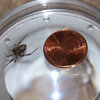Reluctant Widow Mother
Arachnosquire
- Joined
- Aug 24, 2021
- Messages
- 70
In the warmth of fall, my mother's patio was infested with itty-bitty black widow spiderlings and she (understandably) wanted to get rid of them. Her first attempt failed, so I captured one of the spiderlings and decided to raise it. My mother assures me she doused its web with poison, but "Doug" lives and seems to be none the worse for wear. The earliest picture I have of him is in his web on the patio on the 27th of September. At that point, the spiderling had molted at least twice: once in the egg sac (or so I've read) and once in "his" current web. "Doug" molted again fairly recently and once more yesterday, so "he" is in "his" fifth instar (at least). In my opinion, "Doug" should have his emboli at this size, but there's no sign of them.
I thought "Doug" was growing too slowly to be a female, but the spider in question has had a growth spurt. It is getting darker in color and although it is now about the size of an adult male (perhaps bigger), I see no evidence of emboli. I've been curious about black widows, so I have many photos of spiderlings and mature males and females. I'm not sure how many pics I'm allowed to share on this forum, so I'll post three: 1) a picture of a mature male black widow next to a penny 2) a picture of "Doug" next to a penny after his molt and 3) one more pic of "Doug" after yesterday's molt. He or she is nearly large enough to move to a proper enclosure. I have to be sure the spider can't fit through the ventilation holes or access door.
Male Black Widow Next to a Penny ("I has a money. You touch; I bite):

"Doug" Next to a Penny ("his" legs are tucked in, but I'd say he's close in size to the above male, maybe bigger). It's not as good a picture. I apologize in advance:

Let's try for one more:

I think Doug is a dudette. Why? 1) same size or larger than the fully-mature male above, 2) no sign of emboli, 3) seems to be getting darker with each molt and 4) has a fairly well-defined hourglass that is reddish, 4) No lighter longitudinal stripe bifurcating the ventral cephalothorax.
If "Doug" isn't a dude, what would you recommend as an enclosure as soon as she is large enough she won't fit through ventilation holes? Black widows can't climb plastic or glass, so she will need nesting material.
Those of you who have raised multiple black widow spiderlings: What do you think? Is this a male or female black widow?
I thought "Doug" was growing too slowly to be a female, but the spider in question has had a growth spurt. It is getting darker in color and although it is now about the size of an adult male (perhaps bigger), I see no evidence of emboli. I've been curious about black widows, so I have many photos of spiderlings and mature males and females. I'm not sure how many pics I'm allowed to share on this forum, so I'll post three: 1) a picture of a mature male black widow next to a penny 2) a picture of "Doug" next to a penny after his molt and 3) one more pic of "Doug" after yesterday's molt. He or she is nearly large enough to move to a proper enclosure. I have to be sure the spider can't fit through the ventilation holes or access door.
Male Black Widow Next to a Penny ("I has a money. You touch; I bite):

"Doug" Next to a Penny ("his" legs are tucked in, but I'd say he's close in size to the above male, maybe bigger). It's not as good a picture. I apologize in advance:

Let's try for one more:

I think Doug is a dudette. Why? 1) same size or larger than the fully-mature male above, 2) no sign of emboli, 3) seems to be getting darker with each molt and 4) has a fairly well-defined hourglass that is reddish, 4) No lighter longitudinal stripe bifurcating the ventral cephalothorax.
If "Doug" isn't a dude, what would you recommend as an enclosure as soon as she is large enough she won't fit through ventilation holes? Black widows can't climb plastic or glass, so she will need nesting material.
Those of you who have raised multiple black widow spiderlings: What do you think? Is this a male or female black widow?
Last edited:
























